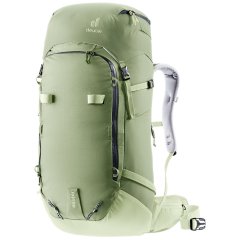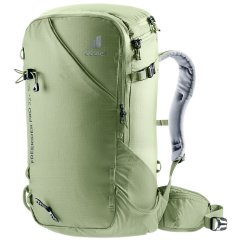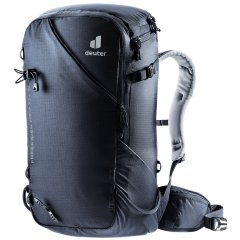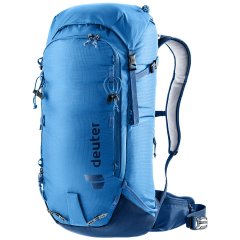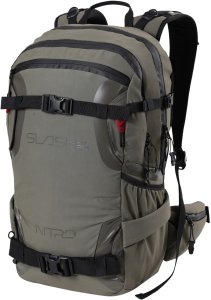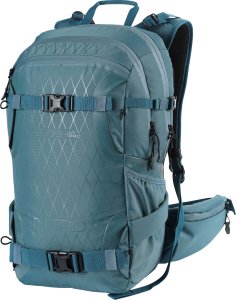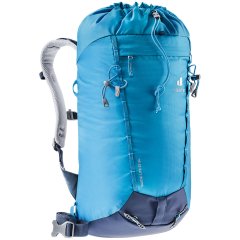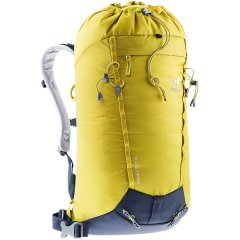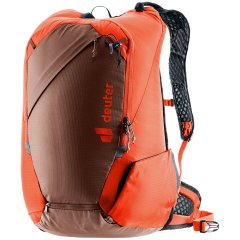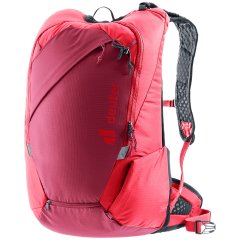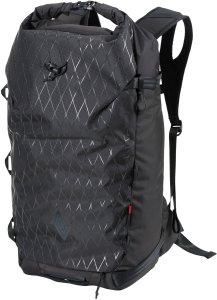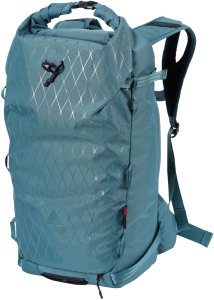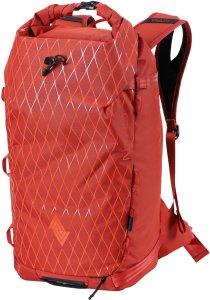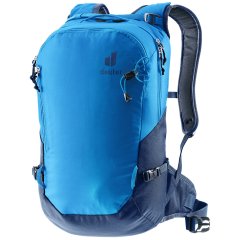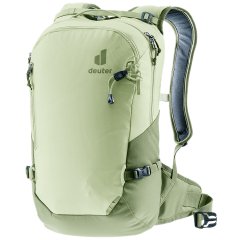Ski & Snowboard Backpacks
Backpacks suitable for snowboarding, skiing, or ski mountaineering are becoming increasingly popular. However, not every sports backpack meets specific requirements and important safety criteria, so it's important to clarify for what purposes you intend to use the backpack. Key advantages of backpacks suitable for skiing include durability in challenging conditions, resistance to moisture, and the ability to withstand heavy loads.
- Free delivery
Backcountry backpack Deuter Durascent 44 + 10 Cinnamon-Ink
Your price (incl. tax) €253.81 - Free delivery
Backcountry backpack Deuter Freescape Pro 38+ SL Grove-Mineral
Your price (incl. tax) €211.50 - Free delivery
Backcountry backpack Deuter Freerider Pro 32+ SL Grove-Mineral
Your price (incl. tax) €188.42 - Free delivery
Backcountry backpack Deuter Freescape Lite 26 Neptune-Nightblue
Your price (incl. tax) €173.04 - Free delivery
Backcountry backpack Deuter Freescape Lite 26 Papaya-Umbra
Your price (incl. tax) €173.04 - Free delivery
Backcountry backpack Deuter Guide Lite 22 SL Azure-Navy
Your price (incl. tax) €146.12 - Free delivery
Backcountry backpack Deuter Guide Lite 22 SL Greencurry-Navy
Your price (incl. tax) €146.12 - Free delivery
Backcountry backpack Deuter Updays 20 Nightblue-Neptune
Your price (incl. tax) €134.58 -
Backcountry backpack Deuter Freecline 15 Neptune-Nightblue
Your price (incl. tax) €96.12 -
Backcountry backpack Deuter Freecline 15 Mineral-Grove
Your price (incl. tax) €96.12
Snowboard and Ski Touring Backpacks: Equipment for Mountain Adventures
The category of ski touring and freeride backpacks represents the pinnacle of specialized design for all who leave marked slopes and venture into the backcountry. These backpacks are constructed with specific needs in mind, whether you're heading out for ski touring or freeriding. It's not just about carrying equipment, but carrying it smartly, safely, and efficiently. Ski touring backpacks are designed to minimally restrict movement during ascents on skins while providing maximum stability and comfort during powder descents.
There are several reasons to choose a specialized backpack from this category. The main one is safety. The vast majority of models feature an separate safety pocket for avalanche equipment (shovel and probe), ensuring immediate access in a critical situation. Another key element is the equipment attachment systems – options for attaching skis to the backpack (diagonally, A-frame) or a snowboard (vertically/horizontally), and specialized loops for ice axes or a helmet. Investing in a quality ski touring backpack is an investment in your comfort and, above all, your safety.
How to Choose the Right Ski Touring Backpack
Choosing the right ski touring backpack can be crucial for the success of your entire trip. There isn't one universal reliable model for everyone; the choice depends on the length of your tours, riding style, and personal preferences. Whether you're looking for a backpack for short, single-day ascents or a spacious backpack for multi-day traverses, focus on several key parameters. The best ski touring backpacks are always a compromise between weight, durability, and functionality.
When choosing, focus on the following points to help you narrow down the selection of ski touring backpacks to the ideal candidate:
- Backpack Volume (Size): Volume is the primary decision criterion. For shorter, single-day tours or freeriding near resorts, a volume of 20–30 liters is usually sufficient. These backpacks will hold basic avalanche equipment, a spare layer, a snack, and a drink. For longer ski touring trips or multi-day traverses, where you carry more equipment (e.g., rope, crampons, more food, or bivouac gear), you will need a backpack with a volume of 35–45 liters or more.
- Equipment Attachment (Skis, Snowboard, Ice Axes): The way you attach skis or a snowboard is essential. Ski backpacks offer various systems: diagonal attachment (quick, but less stable), A-frame (attaching skis to the sides of the backpack, more stable for longer carrying), or combined systems. Make sure the straps are robust enough. Snowboard backpacks should allow for secure vertical attachment. Don't forget practical loops for attaching an ice axe (or two ice axes for more technical ski mountaineering) and a helmet net.
- Safety Features and Access: As mentioned, a separate pocket for avalanche equipment is a must. It must be easily and quickly accessible even with gloves on. Backpacks with an integrated back protector are becoming increasingly popular, providing additional protection during falls. An important detail is also an emergency whistle, often integrated into the chest strap buckle. Also consider access to the main compartment – many ski touring backpacks offer not only top loading but also entry via the back panel. This is extremely practical when you have skis attached to your backpack and need to get inside without having to remove all your skis and equipment.
- Back System and Comfort: The back system must fit perfectly. For movement in the mountains, it is crucial that the backpack follows the body's movement, doesn't hinder it, and distributes weight evenly. Look for a ski backpack with well-padded yet low-profile shoulder straps and a sturdy hip belt, which often includes a small pocket for small items. Also, check if the backpack is compatible with a hydration bladder and if it has a special, microfleece padded pocket for goggles. The material should be lightweight and resistant to abrasion and moisture.
Tip: What about waterproofing, water resistance and what terms like water column or breathability mean, we discussed in a specialized article in our guide.
Related Categories You Might Be Interested In
Although ski mountaineering backpacks are highly specialized, your sports activities may be more diverse. If you are looking for a versatile backpack or engage in other mountain sports, check out our other categories, where you will find equipment adapted to different types of movement.
- Hiking backpacks: For classic hiking, offering different back systems focused on comfort during long-term carrying of heavier loads.
- Running backpacks: Ultralight design in the form of vests and small compact backpacks, intended for trail running, where every gram counts and hydration is a priority.
- Cycling backpacks: Focused on stability on the back while cycling, often with an integrated back protector (similar to freeride backpacks) and specific organizers for tools.
- Trekking backpacks: Large-volume backpacks (50 l and more) designed for multi-day treks and expeditions where complete sleeping and cooking equipment needs to be carried.
Popular Ski Touring Backpack Brands
In our range of ski touring backpacks, we focus on brands that are leaders in innovation, safety, and quality craftsmanship. The best ski touring backpacks come from companies that live and breathe mountain sports and understand the needs of users.
- Deuter: The German brand Deuter is a legend in the world of backpacks. Their ski touring and freeride lines benefit from decades of experience in manufacturing backpacks for high-altitude trekking; after all, even classic mountaineering backpacks are their strong domain. Their Alpine back system is designed so that the backpack sits firmly on the back even during technically demanding descents, while also allowing ventilation during ascents. Deuter backpacks are synonymous with durable material, thoughtful details (such as padded goggle pockets), and are often compatible with hydration bladders.
- Nitro: Nitro has its roots deep in snowboarding, and it shows in their backpacks. They are designed primarily for the needs of snowboarders, which is reflected in robust systems for vertical board carrying. Nitro backpacks combine functionality with distinctive style and are an excellent choice for those looking for a reliable backpack primarily for snowboarding and freeriding.
FAQ about Ski Touring Backpacks
What volume ski touring backpack do I need?
For shorter, single-day tours, a volume of 20–30 liters is usually sufficient. For multi-day traverses where you carry more equipment, look for a backpack with a volume of 35–45 liters or more.
Why do I need a special pocket for avalanche equipment?
A separate safety pocket ensures immediate and quick access to a shovel and probe in a critical situation, which is crucial for safety.
What are backpacks with back protectors for?
These backpacks provide additional back protection during falls, which is especially appreciated by freeride riders in the backcountry.
What is the main difference between a ski touring and freeride backpack and a regular hiking backpack?
Ski touring backpacks are designed for movement in the mountains and have key features such as systems for attaching skis or a snowboard and a separate pocket for avalanche equipment.
What does back panel access to a backpack mean?
It allows you to access the main compartment of the backpack without having to remove the skis or snowboard you have attached to the backpack.
Ski Touring, Skiing, or Freeride Backpack for Every Adventurer
The right ski touring backpack is not just storage space; it's your support, comfort, and safety net all in one. When you're ascending a snowy slope on skins, you barely want to notice it, but when conditions worsen or quick access to equipment is needed, it must perform at one hundred percent. Investing in a quality backpack from our selection is an investment in your passion and safety, no matter what ski touring adventures you're planning. Choose your new partner today and be prepared for everything the mountains bring.


